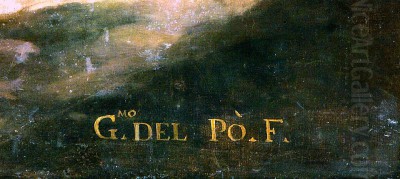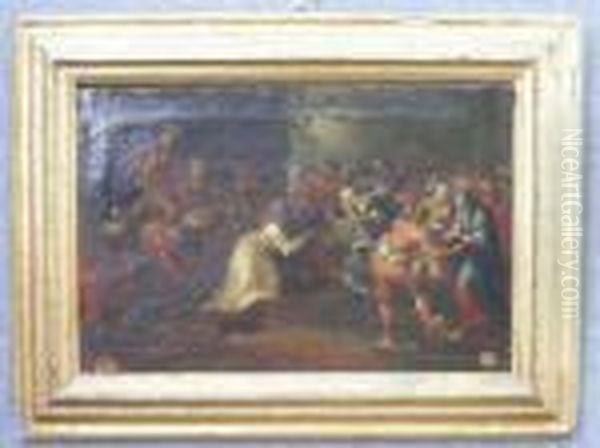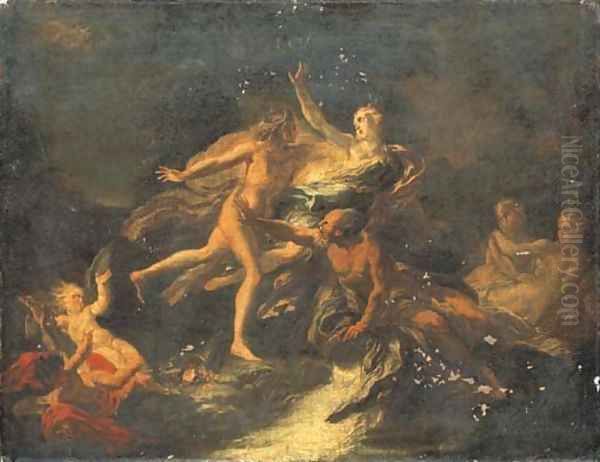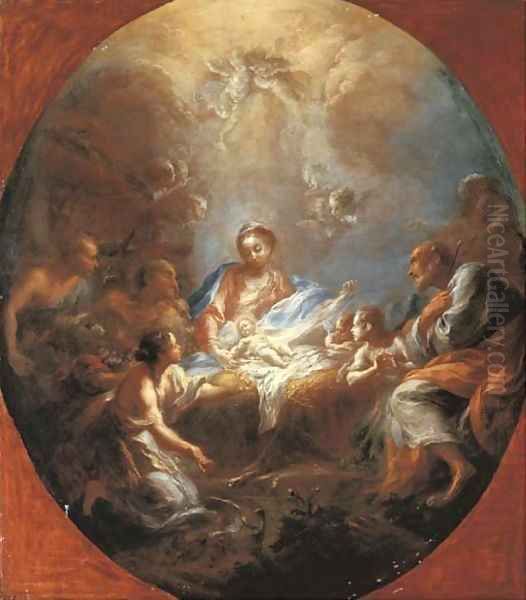
Giacomo del Po (1654–1726) stands as a significant, if sometimes underappreciated, figure in the vibrant artistic landscape of Naples during the late Baroque and early Rococo periods. An Italian painter of considerable skill and versatility, del Po navigated the rich artistic currents of his time, absorbing influences, forging a distinctive style, and contributing substantially to the decoration of ecclesiastical and secular spaces in Naples and its environs. His career reflects the broader stylistic shifts occurring in European art, as the dramatic intensity of the High Baroque gradually gave way to the lighter, more decorative sensibilities of the Rococo. Del Po's oeuvre, encompassing grand fresco cycles, dynamic easel paintings, and intimate cabinet pieces, offers a fascinating window into this transitional era.
Early Life and Artistic Formation in a Thriving Metropolis
Born in Palermo in 1654, according to some sources, though others suggest Rome, Giacomo del Po's artistic journey predominantly unfolded in Naples, which by the latter half of the 17th century had become one of Europe's largest and most artistically dynamic cities. While details of his earliest training remain somewhat obscure, it is known that his father, Pietro del Po, was also a painter, engraver, and draughtsman, likely providing Giacomo with his initial artistic instruction. The family moved to Naples when Giacomo was young, immersing him in a city teeming with artistic talent and fierce competition.
The Neapolitan art scene was then dominated by the towering legacy of Caravaggio and his followers, and the more exuberant Baroque style championed by artists like Luca Giordano (1634-1705), whose prodigious output and "fa presto" (paint quickly) technique left an indelible mark on the city. It is highly probable that the young del Po absorbed lessons from Giordano's dynamic compositions, vibrant palette, and energetic brushwork. Another significant presence was Mattia Preti (1613-1699), whose powerful and dramatic works, particularly his plague-related commissions, also shaped the artistic environment.

Further enriching this milieu was the influence of Roman Baroque masters. Figures like Giovanni Lanfranco (1582-1647), though of an earlier generation, had executed important commissions in Naples, and his illusionistic ceiling frescoes set a standard for grandeur and dynamism. The cross-pollination of ideas between Rome and Naples was constant, with artists and patrons moving between the two cities.
The Neapolitan Artistic Milieu and del Po's Emergence
Naples, under Spanish viceregal rule, was a city of stark contrasts – immense wealth and grinding poverty, fervent religiosity and worldly display. This environment fueled a constant demand for art, from grand altarpieces and sprawling fresco cycles for the city's numerous churches and monasteries, to mythological and historical canvases for the palaces of the nobility. Giacomo del Po emerged within this context, developing a style that, while rooted in the prevailing Baroque idiom, increasingly incorporated a personal sensibility.
One of the most crucial relationships in del Po's career was with Francesco Solimena (1657-1747). Solimena, slightly younger than del Po, would become the undisputed leader of the Neapolitan school in the first half of the 18th century. Sources indicate that Solimena, upon arriving in Naples around 1674, initially worked in the studio of Francesco di Maria and subsequently spent time in Giacomo del Po's workshop. This suggests a period of close association, where mutual influence was likely. While Solimena's star would eventually eclipse many of his contemporaries, del Po maintained a distinct artistic identity. Indeed, some accounts even suggest del Po was considered one of Solimena's most talented early associates or pupils, highlighting the complex interplay of influence and collaboration that characterized Neapolitan workshops.
Other notable painters active in Naples during del Po's formative and mature years included Paolo de Matteis (1662-1728) and Nicola Malinconico (1663-1721), both of whom contributed to the city's rich artistic tapestry. The competitive yet collaborative nature of this environment spurred innovation and a high level of technical proficiency.
Stylistic Evolution: From Baroque Grandeur to Rococo Grace
Giacomo del Po's artistic style is characterized by its dynamism, rich coloration, and a penchant for dramatic, often theatrical, compositions. His early works show a strong adherence to the tenets of Neapolitan Baroque, with robust figures, energetic movement, and a keen sense of light and shadow, reminiscent of Luca Giordano. However, as his career progressed, particularly into the early 18th century, his style began to evolve.

A discernible shift towards a lighter palette, more graceful figures, and a more decorative, almost ethereal quality can be observed. This transition reflects the broader European movement towards the Rococo. Del Po's brushwork became more fluid and feathery, and his compositions often took on a dreamlike, fantastical character. He demonstrated a remarkable ability for "cavalletti" – easel paintings, often of smaller dimensions – which allowed for greater experimentation with color and a more intimate mode of expression. These works often featured mythological or allegorical subjects, rendered with a distinctive blend of energy and delicacy.
The influence of Genoese Baroque painting, known for its elegance and rich color, is also cited by scholars as a factor in del Po's later stylistic development. Furthermore, some art historians have noted an affinity with the opulent and theatrical qualities of Sevillian opera, suggesting that del Po was attuned to various cultural currents that permeated Naples, a major operatic center. This fusion of influences – Neapolitan exuberance, Roman classicism, Genoese elegance, and a burgeoning Rococo sensibility – resulted in a highly personal and recognizable style. His willingness to experiment with bold color combinations and to push the boundaries of conventional Baroque aesthetics marked him as an innovative figure.
Major Fresco Commissions: Adorning Sacred and Secular Spaces
Like many prominent artists of his era, Giacomo del Po was extensively involved in large-scale fresco decorations, which transformed the interiors of churches and palaces into immersive visual experiences. These commissions were a testament to his skill in handling complex compositions on a grand scale and his ability to integrate his work with the surrounding architecture.
One of his most significant fresco projects was for the Basilica of Sant'Antonio in Sorrento. Here, on the ceiling, he depicted dramatic historical events pertinent to the town: the Siege of Sorrento in 1648 and the devastating Plague of Sorrento in 1656. These works would have required not only artistic skill but also a capacity for historical narrative and emotional expression, capturing the turmoil and divine intervention associated with these events. Such commissions were public statements, reinforcing local identity and faith.
In Naples itself, del Po was active in numerous churches. He contributed to the decoration of the Church of Santa Caterina a Formiello. Records indicate collaborations here: for instance, while Francesco Curia painted a Madonna with St. Thomas Aquinas, del Po was responsible for a dynamic St. Dominic defeats the Albigensian Heretics. In another chapel within the same church, del Po painted a St. Catherine of Alexandria, while Luigi Garzi (1638-1721), a Roman painter who also worked in Naples, executed a Visitation. These collaborations were common practice, allowing for the swift completion of extensive decorative programs.

Del Po also undertook commissions for private palaces. He painted frescoes in the Palazzo Caracciolo di Avellino, where he reportedly used a monochrome technique for some rooms, a sophisticated choice designed to enhance the perceived brightness and volume of the spaces. His work could also be found in the Palazzo Cellamare and the Palazzo Francavilla (also known as Palazzo Cellamare on Via Chiaia), where his ceiling frescoes added to the splendor of these aristocratic residences. These secular commissions often involved mythological or allegorical themes, providing opportunities for more sensuous and imaginative depictions than typically found in religious works.
Key Easel Paintings and Thematic Concerns
Beyond his extensive fresco work, Giacomo del Po was a prolific painter of easel pictures, which allowed for a different kind of artistic exploration. These works, often intended for private collectors, covered a range of subjects, from religious narratives and devotional images to mythological scenes and historical episodes.
A notable example is Camilla at War, a painting inspired by Virgil's Aeneid. This subject, depicting the warrior maiden Camilla, allowed del Po to showcase his ability to render dynamic action, martial prowess, and classical narrative. The choice of a Virgilian theme reflects the enduring importance of classical literature in Baroque art and the desire of patrons to associate themselves with heroic and learned subjects.
Another significant work is The Death of Lucrezia (or, as sometimes identified in auction records, La Morte di Saffo – The Death of Sappho). Whether these refer to the same painting with a title variation or two distinct works on themes of tragic heroines, such subjects were popular for their dramatic potential and moral undertones. The Death of Lucrezia, a story of virtue and sacrifice from Roman history, was a recurring theme in art. If The Death of Sappho is a separate work, it would tap into the romantic and tragic lore surrounding the ancient Greek poetess. Such paintings were considered highlights of early 18th-century Neapolitan art, showcasing del Po's mature style with its rich emotional content and refined execution.
His religious easel paintings included works like St. Dominic Defeats the Albigensian Heretics, a theme he also treated in fresco, demonstrating his capacity to adapt powerful compositions to different scales and media. An Adoration of the Crucifix is also attributed to him, fitting within the strong tradition of devotional art in Naples. The painting Maddalena (Mary Magdalene), a subject beloved by Baroque artists for its potential to explore themes of penitence, ecstasy, and sensuality, further illustrates his engagement with popular religious iconography.
A painting titled The Fight between Aeneas and Turnus, dated to around 1700 and now in the Los Angeles County Museum of Art (LACMA), is another testament to his interest in classical epic. This work would have allowed for a display of anatomical knowledge, dynamic figural composition, and the dramatic intensity of combat. Similarly, Donna e Callisto (Diana and Callisto), a mythological scene from Ovid's Metamorphoses, provided scope for depicting the female nude and exploring themes of divine power and human frailty.
These easel paintings, often characterized by their vibrant colors and a sense of "fantasy," as described by contemporary biographers like Bernardo De Dominici (1683-1759) in his Vite de' pittori, scultori ed architetti napoletani, were highly sought after. De Dominici's accounts, while sometimes colored by personal biases, provide invaluable insights into the perception of artists like del Po by their contemporaries.
Interactions with Contemporaries and Artistic Influences
Giacomo del Po's career was interwoven with the broader artistic fabric of Naples, marked by interactions with a host of other painters. His association with Francesco Solimena, as previously mentioned, was particularly significant. Whether as an early mentor, a collaborator, or a friendly rival, their careers were intertwined in the competitive Neapolitan environment. Solimena's eventual dominance created a powerful gravitational pull, but artists like del Po continued to carve out their own niches.
The influence of Luca Giordano is palpable in del Po's work, especially in the energy and scale of his compositions. Giordano's ability to work rapidly and on a vast scale set a benchmark for Neapolitan painters. Del Po also seems to have looked beyond Naples for inspiration. The art of Peter Paul Rubens (1577-1640), with its dynamism, rich color, and sensuous figures, had a pan-European impact, and echoes of Rubenesque qualities can be found in del Po's more exuberant works.
His collaborations, such as those with Francesco Curia and Luigi Garzi in Santa Caterina a Formiello, were typical of the workshop practices of the time. These projects required coordination and a degree of stylistic adaptability. The presence of Roman artists like Garzi in Naples also facilitated the exchange of ideas between the two major artistic centers.
The artistic lineage is also important. Del Po's father, Pietro del Po (1616-1692), was a painter and engraver who had worked with Domenichino (1581-1641) in Rome before moving to Naples. This connection to the classical tradition of Domenichino might have formed part of Giacomo's early artistic inheritance, providing a counterpoint to the more exuberant local styles. His sister, Teresa del Po (1649-1713), was also an accomplished painter and engraver, indicating a family deeply immersed in the arts.
Later Career, Legacy, and Influence
Giacomo del Po remained active until his death in Naples in 1726. His later works continued to show an evolution towards a lighter, more Rococo-inflected style, characterized by a delicate touch and often a more intimate scale, particularly in his easel paintings. He successfully navigated the changing tastes of patrons, adapting his style while retaining his personal artistic voice.
His influence extended beyond painting. Art historians note that del Po's dynamic and often theatrical compositions, with their flowing lines and expressive figures, had an impact on Neapolitan sculpture of the period. Artists working in three dimensions, such as Domenico Antonio Vaccaro (1678-1745), who was himself a painter, sculptor, and architect, were part of the same artistic milieu and would have been familiar with del Po's solutions to compositional and expressive challenges. The interplay between painting and sculpture was a key feature of the Baroque aesthetic, with artists in different media often sharing a common visual language.
While perhaps not achieving the posthumous fame of Solimena or Giordano, Giacomo del Po was a respected and successful artist in his own time. He was, as one scholar noted, one of the few Neapolitan painters of his generation to maintain a continuous tradition, bridging the High Baroque of the late 17th century with the emerging Rococo of the early 18th. His ability to synthesize various influences – from the dramatic power of the Neapolitan school to the elegance of Genoese painting and the nascent grace of the Rococo – made him a pivotal figure.
Rediscovery and Modern Appreciation: Collections and the Art Market
In modern times, Giacomo del Po's works are found in various churches and collections, primarily in Italy. His frescoes, by their nature, remain in situ, offering visitors to Sorrento and Naples a direct encounter with his monumental vision. His easel paintings appear periodically on the art market, allowing for their acquisition by private collectors and public institutions.
Auction records provide some insight into the current valuation of his work. For instance, La Morte di Saffo (The Death of Sappho), an oil on canvas, was offered with an estimate of €2,000-€3,000 at an auction in late 2022. Similarly, Donna e Callisto appeared at the same auction with a comparable estimate. His painting Maddalena (Mary Magdalene), formerly in the collection of Paul Ganz in New York, was estimated at €4,000-€7,000 at an auction in late 2023 and reportedly sold for $103,125, indicating a solid appreciation for his more significant easel works. These figures, while modest compared to the giants of the era, reflect a consistent interest among collectors of Neapolitan Baroque art.
Scholarly interest in Giacomo del Po has grown as part of a broader re-evaluation of the Neapolitan Seicento and Settecento. Publications such as Neil Collins' "Neapolitan Baroque Painting (c.1650-1700)" and Achille della Ragione's "Pittori napoletani del Settecento aggiornati ed inediti" discuss his contributions within the context of the Neapolitan school. These studies help to clarify his role, his stylistic development, and his relationships with other artists, rescuing him from relative obscurity and affirming his place in the history of Italian art. His work is also occasionally featured in travel guides and art historical surveys focusing on Naples and Southern Italy, such as mentions of his frescoes in Palazzo Cellamare or his Adoration of the Crucifix in the context of religious art in the Gargano region.
Conclusion: An Enduring Contribution to Neapolitan Art
Giacomo del Po was an artist of considerable talent and adaptability, a key contributor to the artistic vibrancy of Naples during a period of significant stylistic transition. His journey from the robust drama of the late Baroque to the more refined elegance prefiguring the Rococo mirrors a broader European artistic evolution. Through his grand frescoes in churches and palaces, and his dynamic and often fantastical easel paintings, he left a distinctive mark on the Neapolitan art scene.
He successfully navigated a complex artistic world, learning from masters like Luca Giordano, interacting with influential figures like Francesco Solimena, and collaborating with contemporaries such as Francesco Curia and Luigi Garzi. His ability to absorb diverse influences, from the power of Rubens to the decorative charm of Genoese painting, and to forge them into a personal style, speaks to his artistic intelligence. While the Neapolitan school of the late 17th and early 18th centuries was rich with talent, Giacomo del Po carved out a unique space for himself, celebrated for his rich color, imaginative compositions, and the sheer energy that animates his work. His legacy endures in the sacred and secular spaces he adorned and in the canvases that continue to captivate viewers with their blend of Baroque dynamism and nascent Rococo grace.